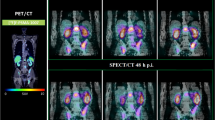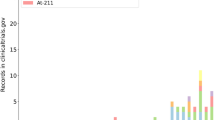Abstract
Osteosarcoma is the most common primary malignant tumour of bone in young patients. The survival of these patients has largely been improved due to adjuvant and neo-adjuvant chemotherapy in addition to surgery. Boron neutron capture therapy (BNCT) is proposed as a complementary therapy, due to its ability to inactivate tumour cells that may survive the standard treatment and that may be responsible for recurrences and/or metastases. BNCT is based on neutron irradiation of a tumour enriched in 10B with a boron-loaded drug. Low-energy neutron capture in 10B creates charged particles that impart a high dose to tumour cells, which can be calculated only knowing the boron concentration. Charged particle spectrometry is a method that can be used to quantify boron concentration. This method requires acquisition of the energy spectra of charged particles such as alpha particles produced by neutron capture reactions in thin tissue sections irradiated with low-energy neutrons. Boron concentration is then determined knowing the stopping power of the alpha particles in the sample material. This paper describes the adaptation of this method for bone, with emphasis on sample preparation, experimental set-up and stopping power assessment of the involved alpha particles. The knowledge of boron concentration in healthy bones is important, because it allows for any dose limitation that might be necessary to avoid adverse effects such as bone fragility. The measurement process was studied through Monte Carlo simulations and analytical calculations. Finally, the boron content of bone samples was measured by alpha spectrometry at the TRIGA reactor in Pavia, Italy, and compared to that obtained by neutron autoradiography. The agreement between the results obtained with these techniques confirms the suitability of alpha spectrometry to measure boron in bone.










Similar content being viewed by others
References
Barth RF, Vicente MG, Harling OK, Kiger WS 3rd, Riley KJ, Binns PJ et al (2012) Current status of boron neutron capture therapy of high grade gliomas and recurrent head and neck cancer. Radiat Oncol 7(146):1–21
Bortolussi S, Altieri S (2013) Boron concentration measurement in biological tissues by charged particles spectrometry. Rad Environ Biophys 52:493–503
Farías RO, Garabalino MA, Ferraris S, Santa María J, Rovati O, Lange F, Trivillin VA, Monti Hughes A, Pozzi ECC, Thorp SI, Curotto P, Miller ME, Santa Cruz GA, Bortolussi S, Altieri S, Portu AM, Saint Martin G, Schwint AE, González SJ (2015) Towards a clinical application of ex-situ Boron Neutron Capture Therapy for lung tumors at the RA-3 reactor in Argentina. Med Phys 42(7)
Gadan MA, Bortolussi S, Postuma I, Ballarini F, Bruschi P, Protti N, Santoro D, Stella S, Cansolino L, Clerici A, Ferrari C, Zonta A, Zonta C, Altieri S (2012) Set-up and calibration of a method to measure 10B concentration in biological samples by neutron autoradiography. Nucl Inst Meth Phys Res B 274:51–56
ICRU Report 46 (1992) Photon, electron, proton and neutron interacion data for body tissues
Johnson TB, Axelsson R, Johansson SAE (1970) X-ray analysis: Elemental trace analysis at the 10–12 g level. Nucl Instr Meth 84:141–143
Maxwell JA, Campbell JL, Teesdale WJ (1989) The Guelph PIXE software package. Nucl Instr Meth Phys Res Sec B43:218–203
Obayashi S, Kato I, Ono K, Masunaga SI, Suzuki M, Nagata K, Sakurai Y, Yura Y (2004) Delivery of 10boron to oral squamous cell carcinoma using boronophenylalanine and borocaptate sodium for boron neutron capture therapy. Oral Oncol 40(5):474–482
Pelowitz DB (2011) MCNPX users manual version 2.7.0. LA-CP-11-00438
Provenzano L, Rodriguez LM, Fregenal D, Bernardi G, Olivares C, Altieri S, Bortolussi S, Gonzalez SJ (2015) Measuring the stopping power of α particles in compact bone for BNCT. Conf, J Phys, S583
Provenzano L, Olivera MS, Saint Martin G, Rodríguez LM, Fregenal D, Thorp SI, Pozzi ECC, Curotto P, Postuma I, Altieri S, González SJ, Bortolussi S, Portu A (2018) Extending neutron autoradiography technique for boron concentration measurements in hard tissues. Appl Radiat Isot 137:62–67
Schwarz R, Bruland O, Cassoni A, Schomberg P, Bielack S (2009) The role of radiotherapy in oseosarcoma. Cancer Treat Res 152:147–164
Stella S, Bortolussi S, Bruschi P, Portella C, Altieri S (2009) Measurement of α particle energy loss in biological tissue below 2 MeV. Nucl Instr Meth 267:2938–2943
Yasko AW (2009) Surgical management of primary osteosarcoma. Can Treat Res 152:125–145
Ziegler JF, Biersack JP, Littmark U (1985) The stopping and range of ions in solids. Pergamon Press, Oxford. Code available on http://www.srim.org
Author information
Authors and Affiliations
Corresponding author
Additional information
Publisher’s Note
Springer Nature remains neutral with regard to jurisdictional claims in published maps and institutional affiliations.
Rights and permissions
About this article
Cite this article
Provenzano, L., Bortolussi, S., González, S.J. et al. Charged particle spectrometry to measure 10B concentration in bone. Radiat Environ Biophys 58, 237–245 (2019). https://doi.org/10.1007/s00411-018-00776-9
Received:
Accepted:
Published:
Issue Date:
DOI: https://doi.org/10.1007/s00411-018-00776-9




